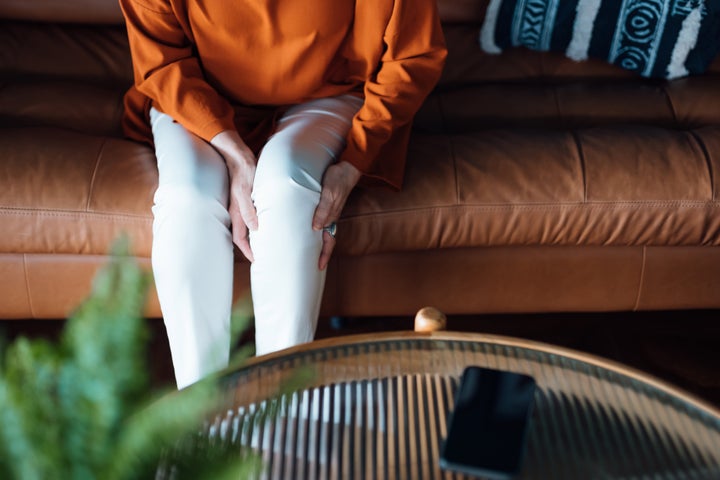
When they happen on the outside, blood clotting can be a good thing to help prevent excessive bleeding after you’ve been injured. Platelets (a type of blood cell) and proteins in your plasma (the liquid part of the blood) band together and form a clot over the injury, which eventually dissolves once the injury has healed.
Blood clots that strike inside the body, however, can sometimes block a vein or an artery and have serious consequences. A clot that blocks a vein deep in the body is what’s known as deep vein thrombosis (DVT). DVTs can form in any deep vein but it typically develops in the lower leg, thigh, pelvis or arm.
“DVTs can occur in younger patients without obvious medical issues,” Dr. Vincent Varghese, a board-certified interventional cardiologist at Deborah Heart and Lung Center in New Jersey, told HuffPost. “Awareness and education are critical in early recognition of DVT.”
Why and how DVT blood clots typically manifest
The blood in our body exists in a highly regulated balance between promoting blood clots (thrombogenesis) and breaking them down (thrombolysis), Dr. K. Francis Lee, medical director of Advanced Vein Care Center in Springfield, Massachusetts, told HuffPost.
“This fine balance is tilted to one side or the other as the need arises,” Lee explained.
But there are risk factors that can disrupt this homeostasis, which is categorised as either acquired or inherited. “Acquired risk factors include common ‘trigger’ events, such as trauma (major bone fractures), major surgery, immobilisation (long-term sedentary or fixed body position, such as following surgery or during long trips), serious infections or cancer,” Lee said.
The venous system is considered a passive flow system with low pressure — the muscles in the legs and arms actively pump blood through the vein system, back to the heart and lungs. “When a person is unable to move (say, after a major abdominal surgery), then those muscles in the legs and arms aren’t actively moving to pump blood effectively,” Varghese said. “This can lead to a slowing down of blood flow and possible blood clots.”
Blood thickens around matter that doesn’t belong in the veins — so things like tissue debris, collagen or fat that may be released into the blood system after a trauma or major surgery can cause blood to clot too. And if there’s damage to the vein walls, this can release naturally-occurring substances that promote blood clotting, according to the American Academy of Orthopaedic Surgeons (AAOS).
“There’s also an overall inflammatory response in these conditions, which can activate the clotting cascade and lead to blood clot development,” Dr. David Nation, a board-certified vascular surgeon at VeinSolutions in Austin, Texas, told HuffPost.
Meanwhile, certain medications (birth control pills, hormone replacement therapy) and diseases (heart failure, kidney disease, cancer) can lead to a thickening of the blood due to various mechanisms, with the potential risk of DVT. There are also dozens of genetic conditions that can increase a person’s risk of not only developing DVTs but early-age heart attacks and strokes.
“As a layperson, it’s not practical to remember nor be concerned with every inherited genetic factor for developing blood clots,” Lee said. “But any devastating occurrences (heart attack, stroke, blood clots, recurrent miscarriages) to a family member in their 20s to 40s in age should raise suspicion for an underlying inherited genetic condition that should be tested.”
“DVTs can occur in younger patients without obvious medical issues. Awareness and education are critical in early recognition of DVT.”
- Dr. Vincent Varghese
COVID-19 can also increase your risk of DVT blood clots
The mechanisms behind why COVID-19 may increase the risk of DVT aren’t fully understood yet, but there are a few theories.
“The virus creates an inflammatory state, which can lead to blood clotting too easily,” Nation said. “It also causes direct endothelial injury to the lung tissue — damage to the cells that line the interior surface of blood vessels — that can release signals into the bloodstream that stimulate clot formation.”
It’s also been suggested the virus may directly activate the clotting cascade through interactions within the bloodstream. All of these effects are more prominent in patients with a severe COVID-19 infection and much less common in mild cases.
Then there’s the immobilisation factor — from spending days in bed to weeks in intensive care — that can lead to slower blood flow, and as a result, increased risk of blood clot formation.
“People with COVID-19 or recovering from it should know the key strategy to avoiding DVT is heightened awareness of symptoms and prevention, with prevention largely provided by anticoagulation medications, better known as blood thinners,” Lee said.
Preventative anticoagulation is appropriate for most, if not all, hospitalised COVID-infected people unless there’s a contraindication. “Specific indications, type, and dose of anticoagulation should be determined by your medical providers,” Lee said.
People who’ve recovered and are being discharged from the hospital don’t need routine preventative measures for anticoagulation.
“People with risk factors that place them at high risk for DVT should be covered with preventative anticoagulation upon discharge from the hospital,” Lee said. “Although not routine, preventative anticoagulation upon discharge for a period of time appears to be beneficial for those high-risk people.”
Lee added: “Certainly, those patients who developed DVT while in the hospital should stay on anticoagulation upon discharge for a period of months, as determined by their physician.”
What about if you were infected with COVID-19 but not sick enough to be hospitalised? You probably don’t require routine preventative blood thinners, but if you have any of the risk factors for DVT — recent surgery, trauma, prolonged immobilisation due to severe illness, family history — you should be preventatively anticoagulated.

The best ways to protect yourself from DVT blood clots
Whether you’re in your usual state of health or recovering from physical trauma, surgery or infection, the best way to avoid DVT is to remove or minimize as many acquired and inherited risk factors as possible.
Know the signs.
Symptoms of DVT include swelling, pain or tenderness in your leg, ankle, foot or arm. Other less common symptoms and signs include hip, thigh or back discomfort, unexplained palpitations, fever, dizziness, coughing with tinged blood or general fatigue and malaise.
“These symptoms may seem unrelated to blood clots in the legs, but they may portend early warnings of a serious DVT blood clot in the making,” Lee said. The quicker you act, the better your outcomes.
Keep moving.
Exercising regularly improves blood circulation and is one of the most important things a person can do to stave off DVT. “Take a break at work if you sit all day by walking around your work area,” Dr. Sanjay Bhojraj, a board-certified cardiologist with Providence Mission Hospital in Orange County, California, told HuffPost. “Schedule longer walks, take standing breaks and make sure to periodically stretch.”
Even something as simple as pumping your feet when sitting for extended periods — by lifting your toes in the air for three seconds with your feet flat on the floor — can give your circulation a boost during times when you’re more sedentary. The more you move around, the less chance you have of developing a DVT blood clot.
Be mindful of medications.
Certain medications, such as birth control pills and chemotherapy, can increase your risk of blood clots.
“When a treatment is unavoidable, be sure to consult with your doctor about prophylactic anticoagulation options,” Lee said, and take your medications exactly as prescribed to maximise efficacy.
Wear compression socks.
Compression socks may help circulation by preventing blood from pooling in the veins, not only improving blood flow but stimulating the body’s own ability to prevent blood clots, according to the American Academy of Orthopaedic Surgeons.
This is a particularly helpful strategy to use when traveling, after surgery or during other bouts of inactivity, like when at your desk working.
Travel smart.
“If you’re planning to travel on an airplane, wear loose-fitting comfortable clothes, drink plenty of water and stay active by walking around every hour or so,” Bhojraj said. “You should also change your sitting position often and avoid crossing your legs throughout your flight.”
Quit smoking.
“Smoking restricts blood flow and increases the risk of blood clots,” Bhojraj said. “It’s never too late to quit.”
Follow a post-surgery protocol.
If you have to undergo major surgery and can’t be physically active, your doctor will probably implement low-dose blood thinners in either pill or injectable forms, or compression devices on your legs, to prevent blood clots, Varghese said. They may also promote early ambulation (walking or other movements) to lower your risk.
The length of time you’re on the protocol will vary, depending on the type of surgery you’ve had and your other risk factors, but following the protocol — and staying in close contact with your doctor about how it’s going — is a super-important part of having a DVT-free recovery.
Seek out your family history.
Look into whether or not you have a family history of blood clot events, such as early-age heart attacks, strokes, DVTs or unexplained pregnancy complications.
“If such family history is present, then consult with your physician or a haematologist on whether genetic or haematological testing may be indicated,” Lee said. “If one family member tests positive for any abnormality, then test everyone among the appropriate family circle in consultation with the physician.”
This knowledge can be lifesaving — not just for you, but possibly for your parents, siblings and children too.
What to do if you suspect a DVT blood clot
If you experience sudden and persistent swelling, pain or tenderness in your leg, ankle, foot or arm that feels like a charley horse (a sudden and painful muscle cramp) and these symptoms stick around for more than a day or two and get worse, make an appointment with your doctor right away — and if you have shortness of breath or experience sharp chest pains, call 911.
When you see your doctor or visit an emergency room, you’ll receive a physical exam. A doctor will ask you questions about your health to help determine the likelihood of a DVT blood clot.
Make sure to let them know if you’ve had a recent surgery or serious injury (think: breaking a bone), cancer, stroke, heart failure, are taking hormones (such as birth control pills) or have traveled for an extended period, as these can all increase your risk.
A DVT blood clot is usually diagnosed by ultrasound of the extremity. Depending on the situation, advanced imaging — including a CT, MRI or venogram — may be needed.
Blood thinners are the go-to therapy, which helps to dissolve the clot, and are either given intravenously or in pill form.
“In the past, the only blood thinning pill was Warfarin, which required frequent bloodwork to monitor levels and efficacy,” Varghese said. “We now have several blood thinning medication options that appear to be safer, better tolerated and don’t require frequent blood work.”
In more severe cases, your physician may recommend removing blood clots from your legs or lungs using minimally invasive procedures or surgery.
“Veins that are cleared of blood clots lead to much healthier outcomes than those that have residual blood clots or scarring remaining inside the vein,” Lee said. “Early diagnosis and aggressive treatment can lead to satisfactory long-term clinical outcomes.”